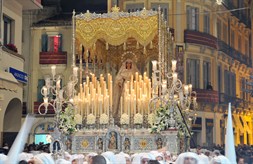The Holy Week of Malaga in the twentieth century
 During the dictatorship of General Miguel Primo de Rivera (1923-30), the presence of armed forces increased in the parades of the Holy Week. The fall of the Rivera’s regime inaugurated a new difficult season for Holy Week in Malaga. With the birth of the Second Republic (1931), we face to the destruction of the artistic heritage of the Brotherhoods at the hands of anti-clerical Republicans. The situation precipitated again in 1936, when after that left wing won elections, the army reacted with a putsch leaded by General Francisco Franco. Throughout the Civil War (1936-39) there was a new period of decline for the Holy Week. The victory of Franco (1939), instead, favoured its revival. Nevertheless, since that moment on, processions were manipulated by the new dictatorial regime, which pretended the parade of its political and military symbols. After the Second World War, despite of economic difficulties, many Brotherhoods have been reconstituted and new tronos have been created. From Sixties to the mid-Seventies, a new economic crisis started.
During the dictatorship of General Miguel Primo de Rivera (1923-30), the presence of armed forces increased in the parades of the Holy Week. The fall of the Rivera’s regime inaugurated a new difficult season for Holy Week in Malaga. With the birth of the Second Republic (1931), we face to the destruction of the artistic heritage of the Brotherhoods at the hands of anti-clerical Republicans. The situation precipitated again in 1936, when after that left wing won elections, the army reacted with a putsch leaded by General Francisco Franco. Throughout the Civil War (1936-39) there was a new period of decline for the Holy Week. The victory of Franco (1939), instead, favoured its revival. Nevertheless, since that moment on, processions were manipulated by the new dictatorial regime, which pretended the parade of its political and military symbols. After the Second World War, despite of economic difficulties, many Brotherhoods have been reconstituted and new tronos have been created. From Sixties to the mid-Seventies, a new economic crisis started.
